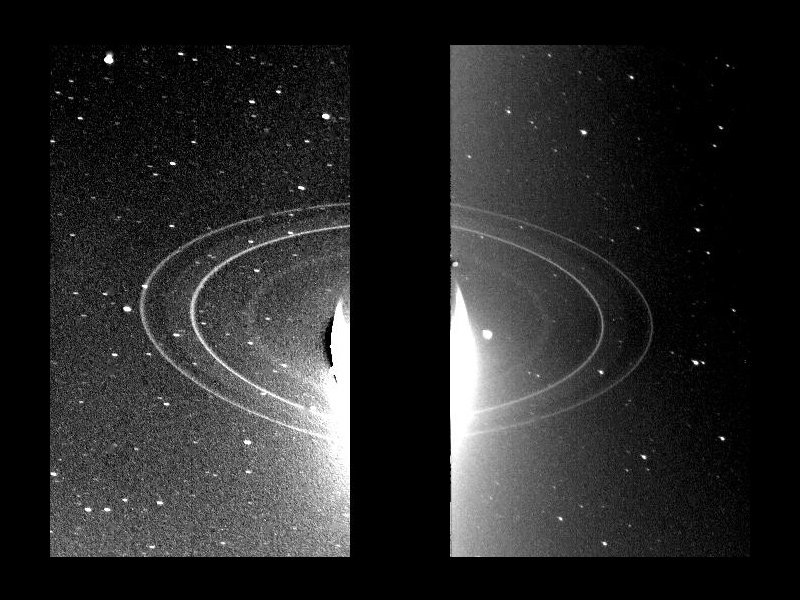The last major planet in the Solar System that orbits our Sun is a distant world, at a distance of more than 30 Astronomical Units* from the Sun and in 2011, completed its first orbit after being discovered in 1846. The orbit lasted a hundred and sixty-five years. This planet is Neptune, aptly named after the Roman God of the Sea.
It is an ice giant, and is 4 times wider than Earth. Most of its mass is made up of icy materials which lie above a small rocky core. Neptune has an atmosphere that is made up of helium, methane and hydrogen. Its neighbor Uranus owes its blue-green colour to methane, but Neptune has a more vivid, brighter blue, which must be caused by some other substance(s).

Here, the Great Dark Spot of Neptune dominates the picture. Picture Credit – NASA/JPL
The planet’s discovery is credited to predictions made by Urbain Le Verrier, and was discovered by Johann Galle in 1846 using mathematical calculations. After Uranus was discovered in 1781, astronomers realized that there must be an eighth planet as Uranus was being pulled slightly away from its usual orbit, and hence Neptune was discovered.

Neptune too has a ring system like the other Outer Planets. So far, 5 main rings (Galle, Leverrier, Lassell, Arago and Adams) and 4 ring arcs have been confirmed. These rings are estimated to be short lived and quite young.

Neptune has 14 known moons, the largest of which is Triton – which was discovered a mere 17 days after the planet itself was found. As Neptune was named after the Roman God of the Sea, its moons have been named after other sea Gods and nymphs from Greek mythology.
Triton is the only moon in our Solar System that orbits its planet in the opposite direction to which the planet rotates. This is known as a retrograde orbit. Triton has exceedingly cold temperatures, and has surface temperatures at around minus 235 degrees Celsius.

Picture Credit – NASA/JPL/USGS
Next comes the controversial body, Pluto. It has had a history of changes in its classification, but is now a dwarf planet, along with 4 others – Makemake, Eris, Ceres and Haumea.
Here’s the reason as to why Pluto is not a planet – It doesn’t meet the criteria that need to be filled to become one. To be classified as a planet,
- The body needs to orbit a Sun.
- It needs to have enough gravity to pull itself into a spherical shape.
- It has to move through its orbit while pulling smaller objects into its gravity or consuming them. (It has to be the major gravitational body in its orbit.)
Pluto doesn’t fulfill the third condition, and therefore is taken to be a dwarf planet.

Another interesting point to note about Pluto is that its plane of orbit is different from those of other planets. The planet revolves around the Sun in a slightly tilted orbit –

Picture Credit – Alex Parker
Pluto is orbited by 5 known moons – namely, Charon, Hydra, Kerberos, Nix and Styx.
The major moon Charon, was discovered in 1978 and is half the size of the world it orbits.
However, the Solar System does not end here. Everything within the Sun’s gravity is part of our Solar System, and there exists more beyond Pluto and its moons.
The Kuiper Belt (pronounced (s)ky-purr) is an asteroid belt similar to the one between Mars and Jupiter, and has been formed by remnants of the early Solar System. It begins at about 30 AU from the Sun – from the orbit of Neptune and extends 20 AU more. Among the estimated millions of bodies found in the Belt, Pluto is one of the most famous.
Astronomers have recorded at least 2,000 of these objects and even though they think there are much much more, they estimate the total mass of all these objects to be only about 10 percent of the Earth’s mass.
And finally, beyond the Kuiper Belt lies the Oort Cloud. It is the most distant region of the Solar System. Even the nearest objects here are much farther away than the outer edge of the Kuiper Belt. To appreciate how far away the Cloud is, we know that Pluto’s tilted orbit brings it about 30 to 50 AU from the Sun. The Oort Cloud however, is thought to be located between 2,000 and 5,000 AU, ending at about 10,000 – 100,000 AU from our star. And NASA’s Voyager 1 – which travels a million miles a day and was launched in 1977, itself will take 300 years to reach the Oort Cloud.
It is believed that the Cloud is a giant shell that surrounds the Sun, planets and Kuiper Belt. You could think of it as an enormous bubble around the Solar System, made of icy objects similar to comets, some of which can be as large as mountains.

Picture Credit – NASA, ESA, J.-Y. Li (PSI), C.M. Lisse (JHU/APL), and the Hubble Heritage Team (STScI/AURA)
Now that we have finally finished our journey through the Solar System, I hope you enjoyed every post and learnt something new!
Thank you for reading and stay safe!!
(*AU – One AU or Astronomical Unit is the distance between the Earth and the Sun – about 150 million kilometers)
Links you might be interested in –
- https://solarsystem.nasa.gov/planets/neptune/overview/
- https://solarsystem.nasa.gov/planets/dwarf-planets/pluto/overview/
- https://solarsystem.nasa.gov/moons/pluto-moons/in-depth/
- https://solarsystem.nasa.gov/solar-system/kuiper-belt/in-depth/
- https://solarsystem.nasa.gov/solar-system/oort-cloud/in-depth/

Super informative and interesting, as always!
LikeLiked by 1 person
Thank you!!😊
LikeLike